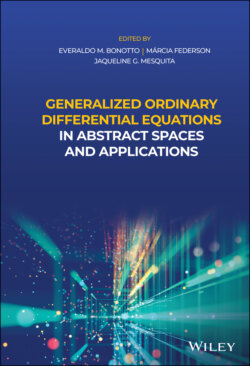Читать книгу Generalized Ordinary Differential Equations in Abstract Spaces and Applications - Группа авторов - Страница 10
Foreword
ОглавлениеSince the origins of the calculus, the development of ordinary differential equations has always both influenced and followed the development of the integral calculus. Newton's theory of fluxions was instrumental for solving the equations of mechanics, Leibniz and the Bernoulli brothers explored the differential equations solvable by quadrature, Euler developed similar numerical methods for computing definite integrals and approximate solutions of differential equations, that Cauchy converted into existence results for the integral of continuous functions and the solutions of initial value problems.
Following this distinguished line, Jaroslav Kurzweil solved in 1957 the delicate question of finding optimal conditions for the continuous dependence on parameters of solutions of ordinary differential systems. To this aim, he introduced a new concept of integral generalizing Ward's extension of the Perron integral, and showed how to define it through a technically minor but basic modification of the definition of the Riemann integral. It happened that, under this type of convergence, the limit of a sequence of ordinary differential equations could be a more general object, a generalized differential equations, defined in terms of the Kurzweil integral. As it often happens in mathematics, a similar integral was introduced independently in 1961 by Ralph Henstock during his investigations on the Ward integral.
This new theory, besides providing a simple, elegant, and pedagogical approach to the classical concepts of Lebesgue and Perron integrals, shed a new light on many classical questions in differential equations like stability and the averaging method. The theory was actively developed in Praha, around Kurzweil, by Jiří Jarník, Štefan Schwabik, Milán Tvrdy, Ivo Vrkoč, Dana Fraňková, and others. Their results are beautifully described in the monographs Generalized Ordinary Differential Equations of Schwabik and Generalized Ordinary Differential Equations of Kurzweil.
Contributions came also from many other countries. In particular, inspired by the fruitful visits of Márcia Federson in Praha and the enthusiastic lectures of Štefan Schwabik in São Carlos, a school was created and developed at the University of São Paulo and spread into other Brazilian institutions. Those researches gave a great impetus to the theory of generalized ordinary differential equations from the fundamental theory to many new important applications.
Because of its definition through suitable limits of Riemann sums, the Kurzweil–Henstock integral directly applies to functions with values in Banach spaces. This is particularly emphasized by the monograph Topics in Banach Space Integration of Schwabik and Ye GuoJu. It was therefore a natural and fruitful idea to consider generalized ordinary differential equations in Banach spaces, not for just the sake of generality, but also because of their specific applications, and in particular their use in reinterpreting the concept of functional-differential equation. This is the viewpoint adopted in the present substantial monograph, whose red wire is to show that many types of evolution equations in Banach space can be treated in an unified and more general way as a special case of the Kurzweil generalized differential equations.
The general ideas are introduced and motivated through an elegant treatment of the measure functional differential equations, where in the integrated form of the differential equation, the Lebesgue measure is replaced by some Stieltjes one. The approach covers differential equations with impulses and the dynamic equations on time scales. The generalized differential equations in Banach spaces are then introduced and developed in a systematic way. Most classical problems of the theory of ordinary differential equations extending to this new and general setting. This includes the existence, continuation, and continuous dependence of solutions, the linear equations, the Lyapunov stability, the periodic and bounded solutions, the averaging method, some control theory, the dichotomy theory, questions of topological dynamics, and the measure neutral functional differential equations.
It is not surprising that the richness and wideness of the content of this substantial monograph is the result of the intensive team activity of 14 contributors: S.M. Afonso, F. Andrade da Silva, M. Ap. Silva, E.M. Bonotto, R. Collegari, F.G. de Andrade, M. Federson, M. Frasson, L.P. Gimenes, R. Grau, J.G. Mesquita, M.C. Mesquita, P.H. Tacuri, and E. Toon. Most of them have already published contributions to the area and other ones got a PhD recently in this direction. Each chapter is authored by a selected subgroup of the team, but it appears that a joint final reading took place for the final product. Each chapter provides a state-of-the-art of its title, and many classes of readers will find in this book a renewed picture of their favorite area of expertise and an inspiration for further research.
In a world where, even for scientific research, competition is too often praised as a necessary driving force, this monograph shows that the true answer is better found in an open, enthusiastic, and unselfish cooperation. In this way, the book not only magnifies the work of Jaroslav Kurzweil and of Štefan Schwabik but also their wonderful spirit.
October 2020
Jean Mawhin
Louvain-la-Neuve, Belgium
